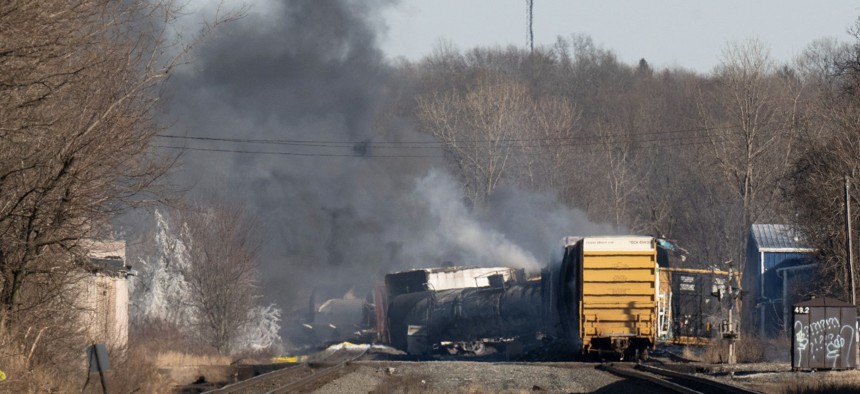
The 50-car train came off the tracks late Feb. 3 near the Ohio-Pennsylvania state border, sparking a massive fire and evacuation orders. The train was shipping cargo from Madison, Ill., to Conway, Pa., when it derailed in East Palestine, Ohio. DUSTIN FRANZ/AFP via Getty Images
How Federal Agencies Are Responding to the Toxic Train Derailment in Ohio
Federal employees have deployed for investigative and cleanup efforts.
Federal employees across several agencies have deployed to assist in an ongoing crisis in northeastern Ohio, where a train derailment carrying toxic chemicals has created safety concerns and forced evacuations.
Local officials are leading many of the immediate emergency response efforts, including putting out the fires that enveloped the East Palestine community in smoke, but federal investigators and cleanup experts are tackling some of the long-term issues the derailment has caused. Federal officials will determine the most likely cause of the incident and potentially issue enforcement actions for Norfolk Southern, whose 150-railcar train was traveling from Illinois to Pennsylvania when the incident occurred.
The Transportation Department, National Transportation Safety Board and Environmental Protection Agency are all involved in the response. Here is a look at their roles:
- NTSB: The safety board is the lead federal investigative agency looking into the derailment. Its teams include hazardous materials investigators and specialists, as well as mechanical, operations and track experts. They immediately deployed staff to gather “perishable evidence” and have examined a black box-type device, interviewed train staff and reviewed footage of the event. Michael Graham, an NTSB board member, said his staff will “methodically and systemically review all evidence.” That will eventually lead to a probable cause determination and, potentially, safety recommendations. All told, NTSB has nine investigators involved, as well as four engineers in its labs, according to Jennifer Gabris, an agency spokesperson.
- EPA: The agency is leading cleanup operations and in charge of responding to the release of hazardous substances into the environment. EPA has conducted 24-hour air monitoring at the site to determine whether residents can return, which local leadership permitted last week. It has conducted air and water sampling and determined exactly which materials were released, and helped screen nearly 400 homes and other buildings to ensure their safety. The agency said it will develop a plan with local leaders to eventually phase out its air monitoring and as of this week it no longer is detecting any levels of concern in the impacted communities.
EPA has informed Norfolk Southern it may be liable to reimburse EPA for all of the expense it incurs for its work. The company has already begun reimbursing impacted individuals and businesses for their losses.
“As soon as EPA was notified of the Norfolk Southern train derailment on Friday, Feb. 3, EPA personnel were on-site by 2 a.m. Saturday morning to assist with air monitoring,” EPA Region Five Administrator Debra Shore said on Tuesday. “Since then, EPA has been boots-on-the-ground, leading robust air-quality testing—including with the state-of-the-art ASPECT plane and a mobile analytical laboratory—in and around East Palestine.”
She added she spoke to Gov. Mike Dewine, R-Ohio, to reaffirm EPA will be on location as long as necessary. As of Monday, EPA had six staff and 16 contractors on the ground offering assistance.
- Transportation Department: Many Republican lawmakers have been quick to heap blame on Secretary Pete Buttigieg, though Transportation is taking more of a background role in incident response. Its Federal Railroad Administration and Pipeline and Hazardous Materials Safety Administration have around 10 employees deployed to assist NTSB in its investigation to make a root cause analysis, according to Warren Flatau, an FRA spokesman. It will eventually determine whether any regulatory non-compliance occurred, but it will not complete that investigation until after NTSB completes its work. If it does make such a determination—which Flatau stressed is not necessarily the case—it would then issue enforcement actions. The process will play out over many months.
“We are in a support role,” Flatau said.
NEXT STORY: When Disasters Hit, Governments Need to Mobilize







